
Rock-by-rock descriptions
When Thurston Hall was expanded in 2022-24 the East and West Rock Parks were moved to their current location on the Pew Engineering Quad. Professor Geoff Abers, Chair of the Department of Earth and Atmospheric Sciences, used the move as an opportunity to configure the rocks in an arrangement better suited to using them for educational purposes.
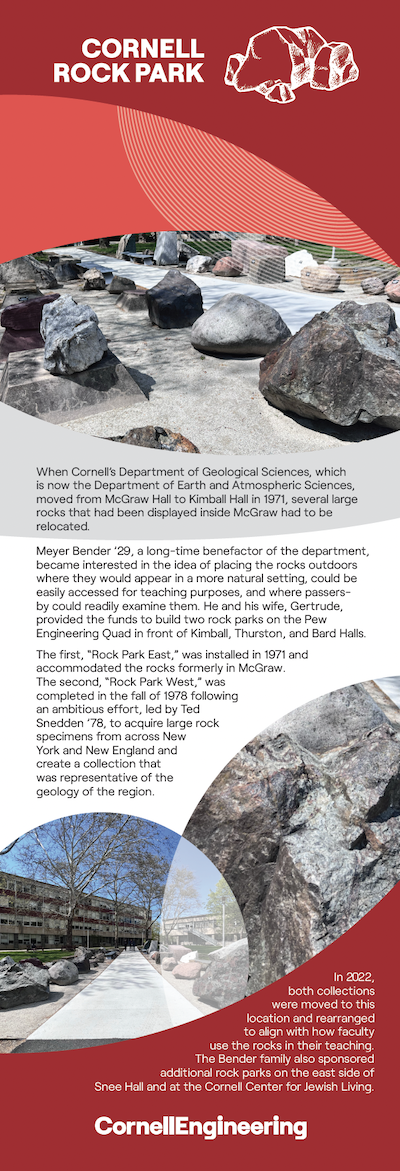 Although the rocks in the rock park may be classified in a number of ways, no single classification scheme is adequate for all of them. Each rock is distinct from all the others and must be considered separately. For this reason a short description of each specimen follows, to aid the observer in inspecting the collection. Each description includes information about the rock’s composition and the minerals visible to the naked eye; where (and in some cases how) the rock was procured; and its uses, both geologic and economic. The age of the rock is given by specifying a geologic time period and, when known, the name of the particular geologic formation to which the rock belongs. A geologic time scale has been provided so that the reader may translate the named geologic periods into approximate ages of formation.
Although the rocks in the rock park may be classified in a number of ways, no single classification scheme is adequate for all of them. Each rock is distinct from all the others and must be considered separately. For this reason a short description of each specimen follows, to aid the observer in inspecting the collection. Each description includes information about the rock’s composition and the minerals visible to the naked eye; where (and in some cases how) the rock was procured; and its uses, both geologic and economic. The age of the rock is given by specifying a geologic time period and, when known, the name of the particular geologic formation to which the rock belongs. A geologic time scale has been provided so that the reader may translate the named geologic periods into approximate ages of formation.
Because the specimens are so diverse, the rock parks may appear to lack a uniform arrangement. When the rocks are examined individually, the observer will find that they acquire distinct personalities. The rocks represent great numbers of years that may be determined and listed but not truly comprehended. The geologists’ view of time is necessarily a long one, and so the rock parks—with some specimens older than one billion years—provide an ideal place for quiet reflection in the fast-paced environment of Cornell University.
You will find below a short description of each of the 40 rocks in the Pew Engineering Quad rock park along with where each rock was collected.
Revision of this interpretive text was done in cooperation with the Paleontological Research Institution in Ithaca. Special thanks to Cornell EAS Professor Warren Allmon and to Professor Carlton Brett of the University of Cincinnati, Cornell EAS Professor Emeritus Teresa Jordan, and Cornell EAS graduate student Kyle Dayton for sharing information and comments on earlier drafts of the text.
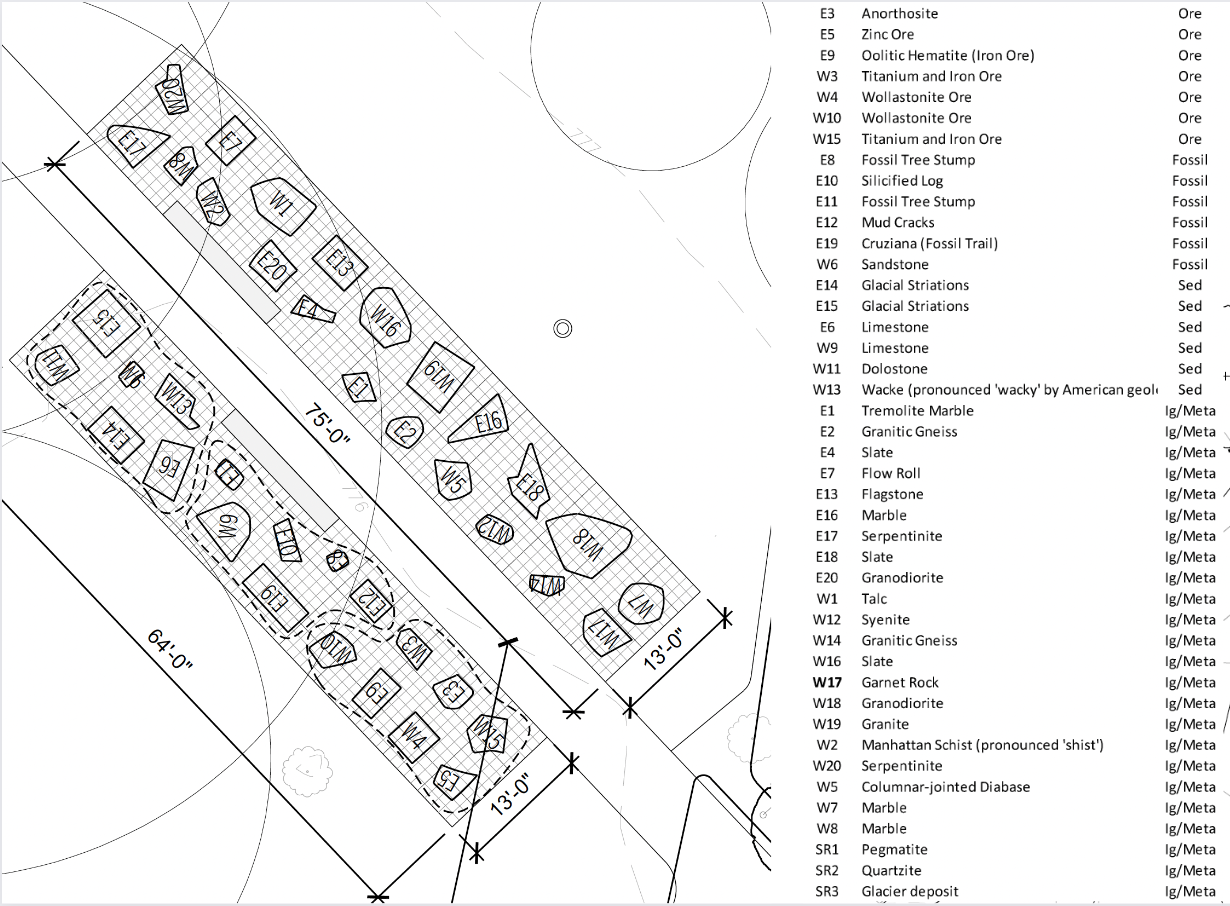
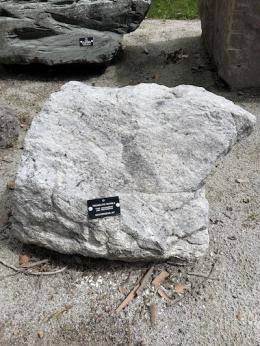
E1 Tremolite Marble
Minerals: tremolite (needle-shaped crystals), talc (flakes), and calcite (granular crystals)
Source: Balmat, St. Lawrence County, New York
The talc and tremolite in this rock were mined for industrial use as a filler in paints and other products. The minerals in this rock are fluorescent, producing bright colors when viewed under both long and short-wave ultraviolet light. The rock is of Precambrian age, (older than 542 million years ago), and was probably produced by hydrothermal alteration (reaction of hot, mineral-rich fluids) of preexisting carbonate-rich sedimentary or metasedimentary rocks. Thus the rock is metamorphic.
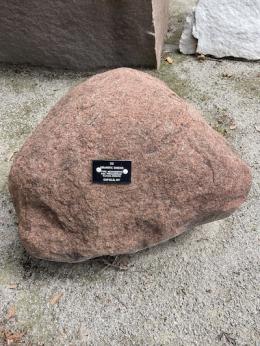
E2 Granitic gneiss (glacial erratic)
Minerals: quartz (clear to white, very hard), hornblende (black), biotite (black flakes), and feldspar (pink-red)
Source: Enfield, Tompkins County, New York
The banding of light and dark minerals in this rock show it to be metamorphic and not igneous. Its probable origin is the Grenville Province of the Canadian Shield, which includes the central Adirondack Mountains of NY State. This rock is a glacial erratic, carried from its source and rounded by glacial ice sometime in the past 2 million years or so.
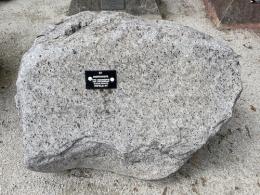
E3 Anorthosite glacial erratic
Minerals: plagioclase (dark gray to black feldspar; the large blocky crystals), with very small garnets (small, iron-rich crystals that are more resistant to weathering than the plagioclase crystals, they have weathered to a rusty brown color)
Source: Enfield, Tompkins County, New York
This rock originated as a magma body deep in the crust, which cooled to form an igneous rock. It was later altered by tectonic forces into a metamorphic rock. The matrix of this rock is fine-grained plagioclase. The rock is of Precambrian age, (older than 542 million years ago), possibly derived from the large bodies of anorthosite in Ontario or Quebec and carried into the Finger Lakes area by glaciers.
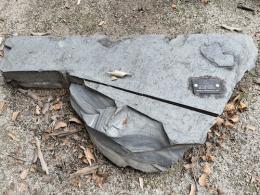
E4 Slate
Composition: recrystallized oriented clay minerals and microcrystalline mica flakes
Source: Middle Granville, Washington County, New York
Slate is a metamorphic rock formed when sedimentary rocks such as shale or siltstone are deeply buried and subjected to high temperatures and pressures. The loss of pore water and the high pressure cause the platy minerals in the rock to become aligned, forming a rock that has smooth cleavage surfaces and that is generally harder and more durable than shale. For this reason, slate makes an excellent building material, used for roof and floor tiles. This rock is from the Mettawee Formation and dates to the late Precambrian or early Cambrian (ca. 700-520 million years old).
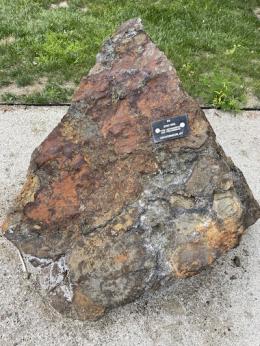
E5 Zinc ore
Minerals: sphalerite (brown crystals of zinc sulfide), quartz (clear white crystals), pyrite (brassy and metallic crystals), hematite (red stain)
Source: Balmat, St. Lawrence County, New York
This rock is of Precambrian age (older than 542 million years). It is from a body of ore directly adjacent to and interfingered with the talc-tremolite body near Gouverneur, New York. These economically valuable elements were concentrated and deposited by hot hydrothermal fluids, leading to the formation of the deposits that exist today. The ore was primarily mined for zinc, but minor quantities of lead, mercury, arsenic, pyrite (sulfur), and silver were also extracted.
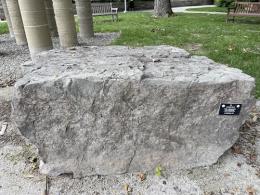
E6 Limestone
Minerals: calcite
Source: Lansing, Tompkins County, New York
This is a piece of the Tully Limestone, from the former limestone quarry at Portland Point, overlooking Cayuga Lake. It dates to the Middle Devonian Period (ca. 380 million years old). Limestone is a sedimentary rock composed almost entirely of calcium carbonate (CaCO3) in the form of the mineral calcite, which in this case was precipitated from seawater by marine organisms, including algae, corals, and mollusks. This rock also has a few layers of silt and clay (slightly brown), which show the bedding surfaces (the two long sides). The limestone at Portland Point was originally quarried for making cement, but was later used for crushed stone and riprap (stone used in piers, breakwaters, seawalls, and landscape stone).
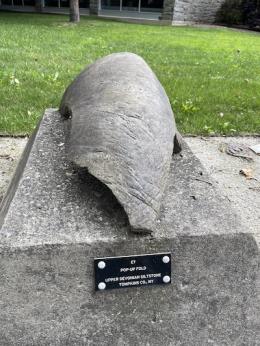
E7 Flow roll/”pop-up” fold
Composition: Fine-grained sand, silt, and clay particles.
Source: Trumansburg, Tompkins County, New York
This specimen illustrates a kind of deformation that takes place in sediments that are not yet lithified (turned to stone by cementation). This “soft sediment deformation” occurs when partially dewatered and compacted sediments on an underwater slope are subjected to slumping, gravity sliding, or some form of density inversion. Since the sediments are partially hardened, they do not flow, but slide into folds, and they later harden (by cementation) into solid sedimentary rock. Note the network of oriented fractures over the top of the fold; these are caused by stresses within the partially hardened sediment during folding. This rock dates to the Middle or Late Devonian period (ca. 390-360 million years ago), when the sediment was accumulating at the bottom of the shallow sea that covered central New York at that time.
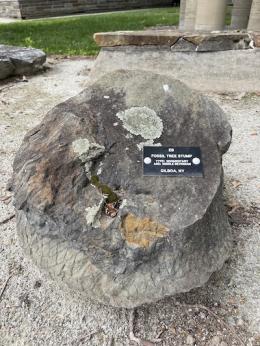
E8 Gilboa tree stump
Source: Gilboa, Schoharie County, New York
This is the fossil stump of one of the earliest known trees, dating to the Middle Devonian Period (ca. 380 million years ago). It was found with numerous others during construction of the Gilboa Reservoir, in the Catskills. The stumps were probably covered in place by a flood that carried a large influx of sediment. As the organic material decomposed, sediments and minerals from the water replaced the stump material bit by bit, until the stump consisted almost entirely of new material formed in the old shape.
The stumps were originally interpreted as having belonged to tree ferns. Then they were assigned to an extinct plant group known as seed ferns, and named Eospermatopteris (meaning “dawn of the seed fern”). In the late 1990s, new discoveries revealed that these trees belonged to an extinct and still poorly-understood group of plants called Cladoxylopsids, which may have been intermediate between Early Devonian vascular plants and ferns.
This specimen was acquired by Cornell from the New York State Museum in the 1920s.
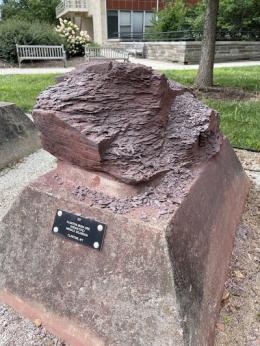
E9 Sedimentary Ironstone
Composition: spherules of hematite (iron oxide)
Source: Clinton, Oneida County, New York
This rock is from the Clinton Formation, which dates to the Silurian Period (ca. 430 million years old). The processes by which it formed are still not fully understood by geologists. The rock consists of tiny spheres 1-2 mm in diameter, which appear to have formed gradually inside sediment as levels of oxygen changed, perhaps as sea level and the intensity of weathering changed around them. Seawater of differing composition may have upwelled from low-oxygen depths, causing iron to precipitate around quartz sand grains or fossil shell fragments.
Although Clinton ironstones were never been mined for iron on industrial scales, they were processed extensively up to the mid 1900s for pigment used in red paints.
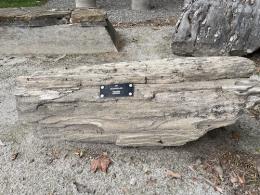
E10 Petrified wood
Composition: microcrystalline silica
Source: Arizona
This log came from a tree that grew in what is now Arizona during the Triassic Period (ca. 225 million years ago). When the tree died, the log was buried in sediment, possibly a silica-rich volcanic ash flow. Over time, the wood was replaced by silica minerals.
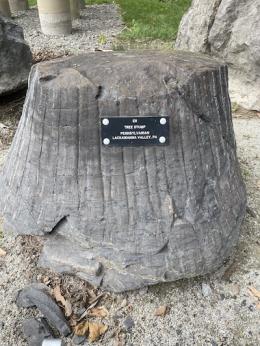
E11 Giant lycopod tree stump
Source: Lackawanna Valley, northeastern Pennsylvania
This tree grew in a coastal swamp during the Pennsylvanian Period (ca. 323-299 million years ago). It belonged to a group of plants called lycopsids, which today live as small herbaceous species on the forest floor (including here in central New York) but which then included trees three feet in diameter and 100 feet tall. When these trees fell over in stagnant water, they did not fully decompose, and formed peat. This peat was eventually compressed by overlying sediment and converted into coal, which is a metamorphic rock made of organic carbon. Some of the black material around this stump is actually coal.
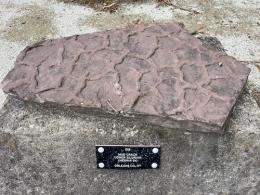
E12 Mud cracks
Source: Orleans County, New York
Mud cracks form when fine sediments are deposited in an environment that periodically changes from very wet to very dry. This can happen near the shoreline of lakes and oceans, in the flood plains adjacent to rivers, or even during a dry spell following a heavy rain. As the wet mud loses water to evaporation, its volume decreases. The cracks are due to the shrinkage of the mud. This rock is a cast of the actual cracks, made when sediments were deposited on top of a lower muddy layer with cracks; you are looking at the underside of the rock layer. This specimen is composed of red silts and sands, indicating that the sediment layer which buried the cracked mud existed in an oxidizing environment – probably in air, not water. The environment of formation was probably a delta plain near the shore, not far above high tide level. The specimen is from the Medina Formation of Early Silurian age (ca. 323-299 million years old).
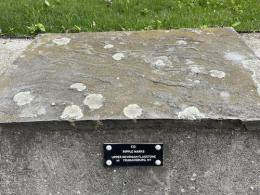
E13 Siltstone with ripple marks
Source: Trumansburg, Tompkins County, New York
Ripple marks are caused by moving water such as tidal or longshore currents. Current ripples can indicate the direction and velocity of currents at the time of deposition, aiding in the reconstruction of paleoenvironments. This sedimentary rock is a sandy shale; the sand makes it reasonably durable, while the silt and clays give it the flat and easily split character necessary for good flagstone. This specimen comes from the Sherburne Formation, which formed in the warm shallow sea that covered central New York in the Late Devonian Period (ca. 370 million years ago).
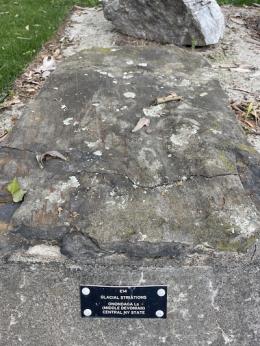
E14 Sandstone with glacial striations
Source: Near Ithaca, Tompkins County, New York
These rocks are shell-rich (calcareous) sandstone, probably from the Enfield Formation. What look like beds of gravel are actually shells of brachiopods, marine organisms that lived in the shallow sea that covered central New York during the Late Devonian Period. The layers formed as water currents swept across the seafloor. Their inclination and orientation allow for the reconstruction of these currents.
More than 370 million years after these rocks formed, glaciers moved repeatedly across this region (between 2 million and 20,000 years ago). Glacially grooved and striated “pavements” are made by movements of glacial ice over a bare rock surface. The ice contains pieces of rock picked up from other rock surfaces that act like grit on sandpaper. Small pieces smooth and polish the surface, while larger pieces cut grooves into the rock. When in place, striated pavements can indicate that glaciers reached that spot and also the direction of their movement.
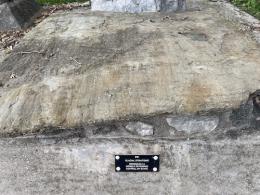
E15 Sandstone with glacial striations
Source: Near Ithaca, Tompkins County, New York
These rocks are shell-rich (calcareous) sandstone, probably from the Enfield Formation. What look like beds of gravel are actually shells of brachiopods, marine organisms that lived in the shallow sea that covered central New York during the Late Devonian Period. The layers formed as water currents swept across the seafloor. Their inclination and orientation allow for the reconstruction of these currents.
More than 370 million years after these rocks formed, glaciers moved repeatedly across this region (between 2 million and 20,000 years ago). Glacially grooved and striated “pavements” are made by movements of glacial ice over a bare rock surface. The ice contains pieces of rock picked up from other rock surfaces that act like grit on sandpaper. Small pieces smooth and polish the surface, while larger pieces cut grooves into the rock. When in place, striated pavements can indicate that glaciers reached that spot and also the direction of their movement.
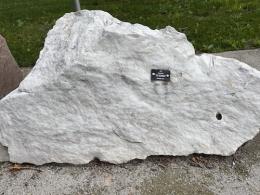
E16 Marble
Minerals: calcite (white, granular, crystalline), talc (tan layers and patches in the rock, especially along planes of shearing and folding)
Source: Danby, Vermont
This white Vermont marble originated as calcium carbonate sediment that accumulated in a warm shallow sea that covered what is now New England during the Cambrian and Ordovician periods (ca. 540-440 million years ago). This sediment was deeply buried by other sediments, and formed limestone. The region then was squeezed by mountain building associated with continent-continent collision, which heated and pressured the limestone, recrystallizing it into marble, a metamorphic rock. Vermont marble is famous around the world as a building stone.
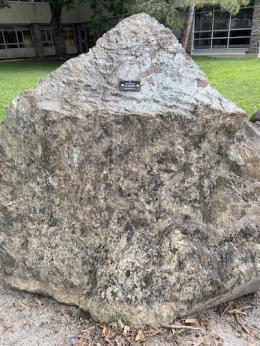
E17 Serpentinite
Minerals: serpentine (a hydrous magnesium silicate, yellow green to green, long fibrous crystals), chlorite (deeper green to yellow green, flat plates and flakes), calcite (veins of white crystals), talc (causing the sometimes greasy-soapy feel of the rock), pyrite (brassy or rusted, in small pods throughout the rock)
Source: Rochester, Vermont
This rock probably originated as oceanic crust (basalt), rich in iron and magnesium. It was then subjected to metamorphism due to a continental collision during the Taconic Orogeny, a mountain building event 440 million years ago in which a volcanic island arc was thrust upon what is today New York and New England. The resulting heat and pressure altered the original igneous minerals (especially olivine), into the metamorphic minerals that exist today.
Although it has been marketed as “marble”, this stone is not marble. Marble consists primarily of calcite, but this rock contains only a small amount of that mineral. For purposes of stonework, however, this rock possesses many of the characteristics of marble, such as hardness, grain, and texture. When cut and polished, this rock is a deep forest green, cut by white veins of calcite.
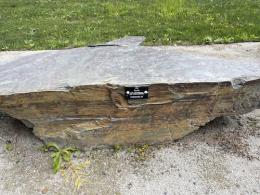
E18 Slate
Source: Fairhaven, Vermont
Slate is a metamorphic rock formed when sedimentary rocks such as shale or siltstone are deeply buried and subjected to high temperatures and pressures. The loss of pore water and the high pressure cause the platy minerals in the rock to become aligned, forming a rock that has smooth cleavage surfaces and that is generally harder and more durable than shale. For this reason, slate makes an excellent building material, used for roof and floor tiles. Most roof slates on the Cornell campus and many other buildings in Ithaca come from the fold belt of the Taconic Mountains on the border of New York State and Vermont.
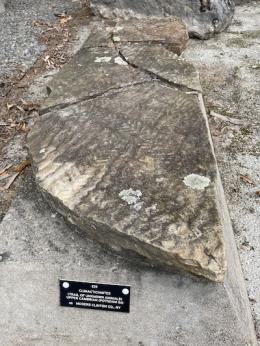
E19 Sandstone with Cruziana trace fossils
Source: Mooers, Clinton County, New York
This sedimentary rock reveals the actions of both waves and ancient life. The top surface of this sandstone slab contains two patterns. The parallel ridges that run in nearly continuous lines diagonally across the surface are current ripples – which are the result of currents in the sea water in which the sand was deposited during the Cambrian Period (ca. 500 million years ago). A second set of ridges-and-hollows cross-cuts the ripple marks at various angles, and generally obscures them, forming herringbone patterns. These are tracks made by an unknown animal, perhaps a trilobite, as it scuttled across the sea floor. These tracks are called Cruziana. Burial of the sand under other sediment preserved the tracks and ripple marks until the sand was compacted and cemented into rock.
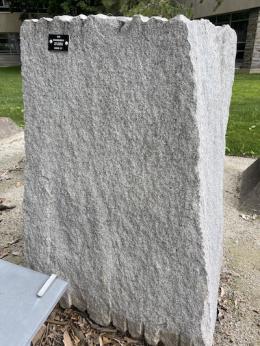
E20 Granodiorite
Minerals: quartz (clear with no cleavage), feldspar (clear to white with good cleavage), biotite (black flakes), and muscovite (clear flakes)
Source: Barre, Vermont
This rock is quarried in Vermont as “granite” and is widely used for building stone. It is not, however, a granite in a strict geological sense, as its composition is too low in silica and potassium. Granodiorite is an intrusive igneous rock. The name “granodiorite” derives from the rock composition, which is intermediate between granite and diorite. Granodiorite is formed from bodies of magma which are generated by the partial-melting of continental crustal materials, after which the melt rises to form intrusive plutons. The molten or partially molten rock never makes it to the surface but cools and solidifies at some depth. The slow cooling allows crystals to grow large, so that the rock has a distinctly crystalline texture. The relatively uniform texture and composition of the plutons near Barre indicate a relatively mobile magma. The concentration of darker mineral crystals (biotite) in one corner of this rock indicates that the magma was heterogenous and probably semisolid, so that the whole could not be homogenized before cooling.
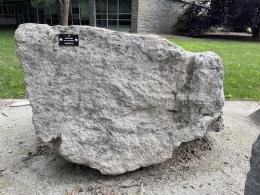
W1 Soapstone
Minerals: talc (white to pinkish or greenish flakes, very soft), tremolite (white, hard needles)
Source: Balmat, St. Lawrence County, New York
“Soapstone” is a metamorphic rock that gets its name from its soapy-greasy luster and texture. It forms by the alteration of igneous rocks that contain abundant minerals with high iron and magnesium content (called “ultramafic” rocks). The main mineral in soapstone is talc. This particular piece of soapstone dates to the Precambrian (older than 542 million years ago). Talc was once used extensively in the chemical industry as a filler in paints. Tremolite, once a waste product of the talc mine, is now used instead of talc, with talc becoming the waste product. The softness of talc is attested to by the deep gouges made on the surface of this rock by the loading equipment. Although talc is a soft mineral (hardness of 1 on the 10 point Mohs scale, with 10 being diamond), the rock is quite cohesive and weathers more quickly from passersby picking at the surface than from rain, wind, snow, or ice.
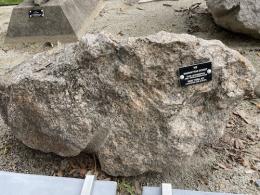
W2 Manhattan schist
Minerals: muscovite (“books” of clear mica flakes – some of the very thick books appear dark brown or gray), quartz (clear, hard, with no cleavage, and generally in thick veins or layers), feldspar (pink and white, with good cleavage), garnet (a few small bright-red granular crystals), iron stain (rust, probably from small grains of hematite dispersed throughout the rock)
Source: New York City, New York (Lexington Avenue and 63rd Street, Manhattan)
Highly metamorphized, the Manhattan schist formed when sedimentary rocks were thrusted deep underground during the Taconic Orogeny, a continental collision which helped form the supercontinent of Pangea 450 million years ago. The high temperatures and pressures resulting from the burial are needed to deform the preexisting sedimentary and create the mineral textures and banding seen today. The preexisting sedimentary rocks likely contained a considerable amount of aluminum, which was needed to form the micas (clear and dark brown flakes) and garnet visible today.
This rock was taken from beneath the streets of midtown Manhattan during the excavation of a new cross-town subway. It was lifted by crane out of a hole in the pavement and loaded onto a Cornell truck for the trip to Ithaca.
The economic significance of the Manhattan Formation is that it is very strong and solid, enabling construction of the tall skyscrapers that give midtown Manhattan its characteristic skyline. The Manhattan schist is deeper below downtown Manhattan, limiting the construction of skyscrapers in that part of the city.
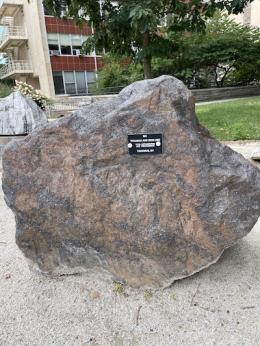
W3 Titanium and iron ore
Minerals: garnet (red, magnetite-ilmenite (purplish-black), plagioclase (green to greenish black), pyrite (brassy), and calcite (clear to white)
Source: Tahawus, Essex County, New York
The ilmenite, plus a minor amount of red garnet, causes the rock to have a purplish tint, and its high iron content makes it extremely dense and heavy. The ore is crushed, concentrated magnetically, and smelted for the titanium – formerly considered a bothersome impurity in the iron. The refined titanium is used as a white pigment in paints and in the manufacture of high-grade steel. The open-pit mine at Tahawus, southwest of Mount Marcy, was one of the largest titanium mines in the world. It closed in 1989.
This piece of mine waste shows the mineral assemblage that accompanies the magnetite ore body. The large vein of pyrite indicates emplacement in the host anorthosite via hot solution of mineral-rich fluids. The mechanics of emplacement for the magnetite body is thought to be similar, but is still in question. The ore body rests in Precambrian basement rock and is probably of comparable age.
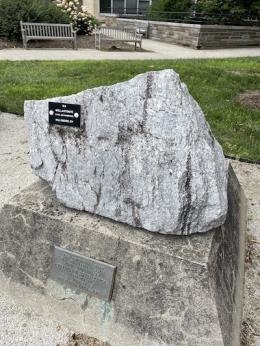
W4 Wollastonite ore
Minerals: wollastonite (white), garnet (red), diopside (green flecks)
Source: Willsboro, Essex County, New York
This wollastonite ore formed when carbonate sedimentary and metamorphic rocks were altered by a hot plutonic igneous body, forming a rock known as skarn. Skarns form as hot fluids from igneous intrusions infiltrate and alter the preexisting rocks in a process called metasomatism to form more complex and unusual mineral assemblages. Crushed wollastonite is used as a filler in paints, rubber, etc. Crushed garnet separated from wollastonite is used as an industrial abrasive.
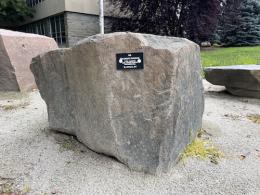
W5 Columnar-jointed diabase
Minerals: plagioclase feldspar (white or clear), pyroxene (gray to black)
Source: West Nyack, Rockland County, New York
This rock is from the Palisades Sill, an igneous intrusion in southeastern New York State and northeastern New Jersey. The Palisades is familiar to residents and commuters north of New York City who can see it on the west side of the Hudson River. During the Late Triassic Period (ca. 200 million years ago), hot magma was injected between layers of rock, driving them apart vertically to form a sill, or thick flat intrusion. As the magma cooled, crystals sank to the bottom of the sill, forming a crystal “cumulate” layer. As the remaining magma solidified, and contracted on cooling, joints began to form in a polygonal or “honeycomb” pattern at the top, and as cooling progressed downward, the joints also propagated downward. The result is a mass of solid rock columns with polygonal cross-sections. These columns can be seen weathering out of the Palisades along the lower Hudson River as a steep, grooved cliff. This specimen is a portion of one of these columns. The polygonal joints can be seen as flat, coated surfaces on the sides of the stone. At some point, the rock column fractured horizontally to form the top and bottom surfaces. Since diabase is a heavy, hard rock, it is quarried and crushed for use in roads and other construction. The rock has long been colloquially called “trap rock” because of its steplike appearance in quarries and outcrops (from the Dutch word trappen for “steps”).
The Palisades Sill is part of a much larger set of igneous rock occurrences found around much of the Atlantic Ocean. These igneous intrusions and extrusions are collectively referred to as a “Large Igneous Province” (LIP), and may have been associated with the mass extinction of species – on land and in the oceans – that occurred at the end of the Triassic Period.
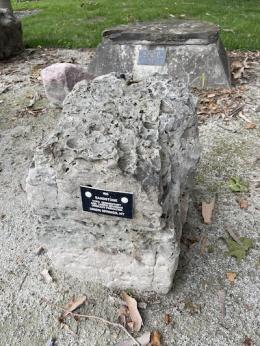
W6 Sandstone
Minerals: quartz grains with layers of fossil calcite shells of brachiopods.
Source: Union Springs, Cayuga County, New York
This is a piece of sandstone from the Oriskany Formation, dating to the Early Devonian Period (ca. 412 million years ago). The uniformly coarse grain size and the beds of shells that are concave-down, indicate deposition on a beach or just offshore of one, where waves arranged the shells. The almost pure quartz composition of the rock is due to source rocks from which the particles were originally derived.
This specimen comes from an outcrop in Yawger’s Woods, near Union Springs, New York. This outcrop has been famous since the 1800s as the “type locality” of the Oriskany Formation, which means the locality from which it was first formally described. The specimen was used in the foundation of a barn.
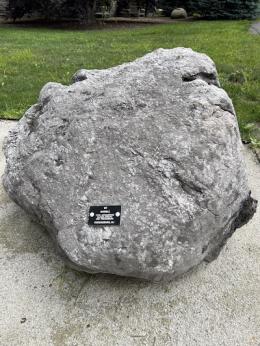
W7 Marble
Minerals: calcite (coarse, crystalline white calcite that has weathered to a muddy brown color on exposed surfaces), zinc ore (both willemite and franklinite – small metallic crystals, back to dark grayish green)
Source: Ogdensburg, New Jersey
This rock comes from the Franklin Marble, a formation which underlies much of the Wallkill River valley between Sparta, New Jersey on the southwest and Warwick, New York on the northeast and is about 1.3 billion years old. The Franklin Marble is exceptionally rich in zinc and has been mined for more than 200 years.
The Franklin Marble was originally a limestone, composed of the mineral calcite (made of calcium carbonate, CaCO3) which was derived from the skeletons of marine organisms. It was then altered by tectonic processes into marble, a metamorphic rock. As a result of metamorphism, the calcite crystals have been etched by weathering along cleavage and twinning planes so that large crystals appear striated. Since the direction of the striations differs from crystal to crystal, the surface of the rock has a herringbone pattern. The calcite weathers faster than the associated willemite and franklinite crystals, so that the latter stand out on the surface, showing themselves to be layered within the rock. Finally, bright green crystals scattered throughout the rock consist of either diopside (as seen in the wollastonite) or serpentine. Ogdensburg, New Jersey is considered the fluorescent mineral capital of the world, and the specimen here fluoresces under UV light.
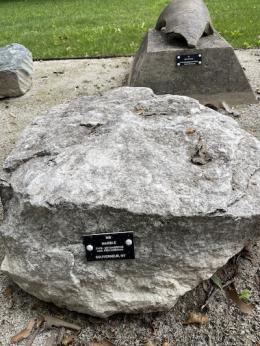
W8 Marble
Minerals: calcite
Source: Gouverneur, St. Lawrence County, New York
This marble is of Precambrian age, and is perhaps a billion years old or more. It was originally a limestone, composed of the mineral calcite (made of calcium carbonate, CaCO3) which was derived from the skeletons of marine organisms. It was then altered by tectonic processes into marble, a metamorphic rock. The various processes that occur during metamorphism produce crystals of various sizes, which is referred to as texture. The texture of this marble is too coarse for use in carving, so it is crushed to make marble chips for landscaping and milled for use as agricultural limestone.
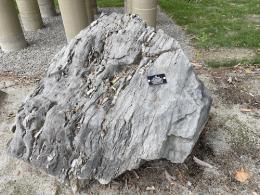
W9 Limestone
Source: Jamesville, Onondaga County, New York
This sedimentary rock is from a carbonate reef consisting of corals, crinoids, bryozoans, and stromatolites. The coral-rich layers alternate with algae-rich layers. Since most of the corals have been replaced with silica, these stand out as individual corals and cherty layers against the more easily weathered calcite of the algae. The black material is chert (also known as flint), which is microcrystalline silica (the same composition as quartz). This rock comes from the Nedrow Member of the Onondaga Limestone, which formed during the Early Devonian period, ca. 400 million years ago.
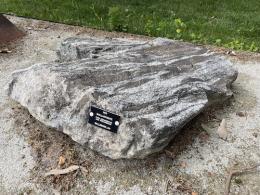
W10 Wollastonite ore
Minerals: wollastonite (white), garnet (red), diopside (green flecks)
Source: Willsboro, Essex County, New York
This wollastonite ore formed when carbonate sedimentary and metamorphic rocks were altered by a hot plutonic igneous body, forming the skarn deposits present in Willsboro. Skarns form as hot fluids from igneous intrudiond infiltrate and alter the preexisting rocks in a process called metasomatism to form more complex and unusual mineral assemblages. Crushed wollastonite is used as a filler in paints, rubber, etc. Crushed garnet separated from wollastonite is used as an industrial abrasive.
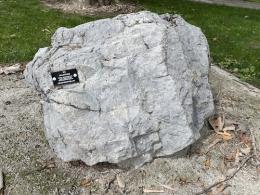
W11 Dolostone
Composition: primarily dolomite, a calcium-magnesium carbonate
Source: Poughkeepsie, Dutchess County, New York
Dolostone is a sedimentary rock formed in either the ocean or, less commonly, in lakes. It is a low-grade metamorphic rock. The original crystals were calcite, which was converted to dolomite by replacement of some of the calcium ions by magnesium ions, perhaps by the influx of magnesium-rich seawater. This process, one of many types of diagenesis of sediments, can occur either on the seabed or after shallow burial, as it involves no great heat or pressure. At a later time, heat and pressure due to burial caused some dissolution of the dolomite, and veins of this mineral formed along fractures in the rock.
This specimen is from the Stockbridge Group, of Ordovician age (ca. 480 million years old). Dolostone is used as crushed stone and riprap material for piers and breakwaters and for flood control for streams.
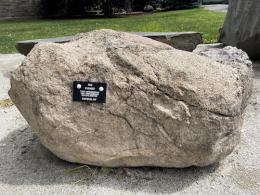
W12 Syenite glacial erratic
Minerals: alkali feldspar (almost the entire rock – large, blocky crystals, tan to light pink) and hornblende (minute amounts of black crystals)
Source: Enfield, Tompkins County, New York
Syenite is a coarse-grained intrusive igneous rock with a general composition similar to that of granite, but deficient in quartz. Note that the large, blocky feldspars weather out of the rock quite easily. These feldspars will eventually break down into clay minerals. This specimen is a glacial erratic; its origin is uncertain, though it is probably from Ontario or Quebec.
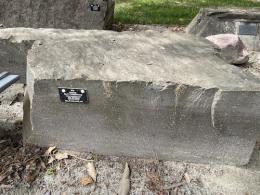
W13 Poorly sorted sandstone
Composition: sand and clay-sized particles
Source: Ellis Hollow, Ithaca, Tompkins County, New York
This rock comes from the Sonyea Group, a set of sedimentary rocks deposited across central New York in the Late Devonian period (ca. 370 million years ago). The rock is dominated by grains the size of sand, but the process by which it was deposited did not fully segregate the grain sizes, leaving some mud mixed with the sand. Deposition of this type of mixed sediment can be observed on the submarine portions of large modern deltas such as the Mississippi delta, which extends some distance into the Gulf of Mexico. This rock, quarried near Ithaca, is from the distal (offshore) margin of the Catskill Delta, which built itself westward into the shallow sea that covered this part of New York during the Devonian. Sand-rich layers such as this one were perhaps deposited at the seaward edge of the delta shelf. Bedding surfaces exhibit slight current ripples, flute casts (impact marks), and current drag marks. Hard and reasonably durable, it makes good building stone. It was used as the primary building stone for most of the older buildings on the Cornell campus.
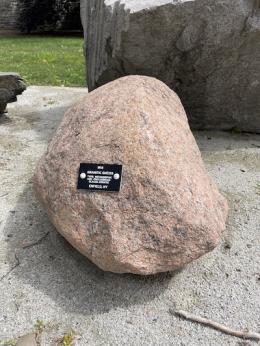
W14 Granitic gneiss glacial erratic
Minerals: quartz (clear to white), feldspar (pink – possibly orthoclase), hornblende (black) and small amounts of garnet (very dark red and very small)
Source: Enfield, Tompkins County, New York
This rock is slightly banded in composition, indicating that it is a metamorphic rock. It is probably of Precambrian age (older than 542 million years old), derived from the basal metamorphic terranes to the north in Canada and carried south by the glaciers.
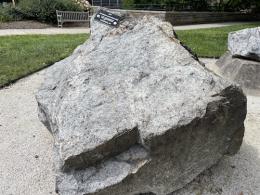
W15 Titanium and iron ore
Minerals: garnet (red, magnetite-ilmenite (purplish-black), plagioclase (green to greenish black), pyrite (brassy), and calcite (clear to white)
Source: Tahawus, Essex County, New York
The ilmenite, plus a minor amount of red garnet, causes the rock to have a purplish tint, and its high iron content makes it extremely dense and heavy. The ore is crushed, concentrated magnetically, and smelted for the titanium – formerly considered a bothersome impurity in the iron. The refined titanium is used as a white pigment in paints and in the manufacture of high-grade steel. The open-pit mine at Tahawus, southwest of Mount Marcy, is the largest titanium mine in the world.
This piece of mine waste shows the mineral assemblage that accompanies the magnetite ore body. The large vein of pyrite indicates emplacement in the host anorthosite via hot solution of mineral-rich fluids. The mechanics of emplacement for the magnetite body is thought to be similar, but is still in question. The ore body rests in Precambrian basement rock and is probably of comparable age.
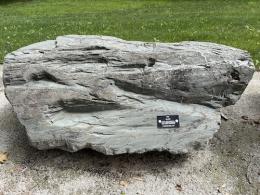
W16 Slate
Source: Fairhaven, Vermont
Slate is a metamorphic rock formed when sedimentary rocks such as shale or siltstone are deeply buried and subjected to high temperatures and pressures. The loss of pore water and the high pressure cause the platy minerals in the rock to become aligned, forming a rock that has smooth cleavage surfaces and that is generally harder and more durable than shale. For this reason, slate makes an excellent building material, used for roof and floor tiles. Most roof slates on campus and many other buildings in Ithaca come from the fold belt of the Taconic Mountains on the border of New York State and Vermont.
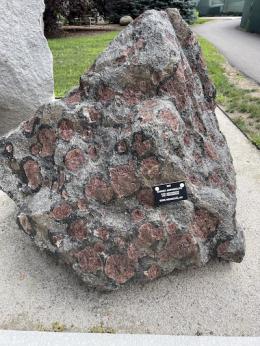
W17 Garnet amphibolite
Minerals: almandine garnet (very large, rounded to irregular red crystals; pervasively sheared, with thin layers of greenish feldspar along shear planes), amphibole (black, in “reaction rims” around the garnets and throughout the matrix), plagioclase (white – chiefly in the matrix – mixed with amphibole, giving a salt and pepper appearance to the matrix), quartz (clear, also in the matrix), biotite (black flakes, large inclusions within the garnet crystals)
Source: Gore Mountain, Warren County, New York
This metamorphic rock from Gore Mountain, in the eastern Adirondacks, is famous for its garnets, which are of a particularly hard variety (hardness 8.5 on the 10 point Mohs scale, with diamond a 10), and which break rather than rounding off, yielding a good abrasive. Wear decreases the size of the grains but not their hardness or sharpness. The fine-quality garnet found here was long mined for use in sandpaper, as well as the grinding and polishing of lenses. Garnet was separated from the amphibole and other minerals by means of density – coarse fragments were taken out in a heavy magnetite slurry, finer fragments by froth floatation. Since garnet is a reasonably dense mineral, a rock with a large percentage of garnet should be fairly dense; this rock is estimated to weigh in excess of two tons. The garnet in this rock is of industrial, not gemstone, grade, because of the high degree of fracturing.
This garnet amphibolite formed during the Ottawan Orogeny around 1 billion years ago through intense metamorphism associated with continent-continent collision. These garnets are some of the largest in the world, and grew to their unusual size due to large rates of fluid flow along faults and fractures nearby during metamorphism. Garnet is the state gem of New York, largely in recognition of the spectacular Gore Mountain garnet amphibolites.
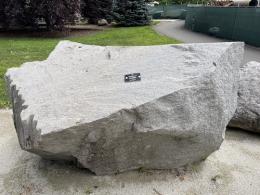
W18 Granodiorite
Minerals: quartz (clear with no cleavage), feldspar (clear to white with good cleavage), biotite (black flakes), and muscovite (clear flakes)
Source: Barre, Vermont
This rock is quarried in Vermont as “granite” and is widely used for building stone. It is not, however, a granite in a strict geological sense, as its composition is too low in silica and potassium. Granodiorite is an intrusive igneous rock. The name “granodiorite” derives from the rock composition, which is intermediate between granite and diorite. Granodiorite is formed from bodies of magma which are generated by the partial-melting of continental crustal materials, after which the melt rises to form intrusive plutons. The molten or partially molten rock never makes it to the surface but cools and solidifies at some depth. The slow cooling allows crystals to grow large, so that the rock has a distinctly crystalline texture. The relatively uniform texture and composition of the plutons near Barre indicate a relatively mobile magma. The concentration of darker mineral crystals (biotite) in one corner of this rock indicates that the magma was heterogenous and probably semisolid, so that the whole could not be homogenized before cooling.
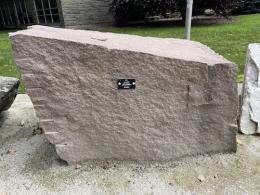
W19 Granite
Minerals: quartz (clear with no cleavage), feldspar (pink to white), and biotite (black flakes)
Source: Quebec, Canada
Granite is an intrusive igneous rock rich in silica-bearing minerals. The pink feldspar is a potash feldspar, which typifies granite. Its origin is probably very similar to the that of specimen E20.
Granites are still quarried today by methods similar to those used for centuries. Large blocks are cut in a relatively deep open pit, and then lifted by log-boom cranes placed around the rim of the pit. Modern-day quarrying shows one or two recent technical innovations, such a metal cranes, high-speed drills, and even thermal lances, which melt their way into the rock. In many cases, but not all, sledgehammers have been replaced by jackhammers, and the stonecutter must rely on an almost uncanny sense of the fabric of the rock in order to know the most profitable and easiest way to cut or break it.
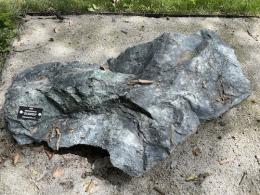
W20 Serpentinite
Minerals: serpentine (a hydrous magnesium silicate, yellow green to green, long fibrous crystals), chlorite (deeper green to yellow green, flat plates and flakes), calcite (veins of white crystals), talc (causing the sometimes greasy-soapy feel of the rock), pyrite (brassy or rusted, in small pods throughout the rock)
Source: Rochester, Vermont
This rock probably originated as oceanic crust (basalt), rich in iron and magnesium. It was then subjected to metamorphism due to a continental collision during the Taconic Orogeny, a mountain building event 440 million years ago in which a volcanic island arc was thrust upon what is today New York and New England. The resulting heat and pressure altered the original igneous minerals (especially olivine), into the metamorphic minerals that exist today.
Although it has been marketed as “marble”, this stone is not marble. Marble consists primarily of calcite, but this rock contains only a small amount of that mineral. For purposes of stonework, however, this rock possesses many of the characteristics of marble, such as hardness, grain, and texture. When cut and polished, this rock is a deep forest green, cut by white veins of calcite.
Donors of rock specimens
Most donors gave not only the rocks but also the use of their equipment and personnel
to load them. We gratefully acknowledge their help.
#W9: Allied Chemicals, Inc., Jamesville Quarry, Jamesville, NY
#E6: Cayuga Crushed Stone Co., Inc., Lansing, NY
#E4: Darius Slate Products Co., Inc., Middle Granville, NY
#W11: Dutchess Quarry, Inc., Poughkeepsie, NY
#W13: Finger Lakes Stone Co., Inc., Ellis Hollow, Ithaca, NY
#E1, #W1: Gouverneur Talc Co., Inc., Balmat, NY
#W4, #W10: lnterpace Corp., Willsboro, NY
#W6: The Hects, Union Springs, NY (farmland)
#E2, #E3, #W12, #W14: Harold and Roger Lane, Enfield, NY (farmland)
#W3, #W15: National Lead Industries, Inc., Macintyre Development, Tahawus, NY
#W5: New York Trap Rock Corp., Division of Lone Star Industries, Inc.,
West Nyack, NY
#W8: North Country Aggregates, Inc., Gouverneur, NY
#E20, #W18, #W19: Rock of Ages, Barre, VT
#E5: St. Joe Minerals Corp., Balmat-Edwards Division, Balmat, NY
#W2: Schiavone Construction Co., New York, NY
#E16, #E17, #W20: Vermont Marble Co., Inc., Proctor, VT
#E18, #W16: Vermont Structural Slate Co., Inc., Fairhaven, VT

